The protective effects and mechanism of myricetin in liver diseases (Review)
- Authors:
- Mi Chen
- Shengnan Zhang
- Xingqiong Huang
- Dandan Zhang
- Dan Zhu
- Changhan Ouyang
- Yankun Li
-
Affiliations: Hubei Key Laboratory of Diabetes and Angiopathy, School of Pharmacy, Hubei University of Science and Technology, Xianning, Hubei 437100, P.R. China - Published online on: February 3, 2025 https://doi.org/10.3892/mmr.2025.13452
- Article Number: 87
-
Copyright: © Chen et al. This is an open access article distributed under the terms of Creative Commons Attribution License.
This article is mentioned in:
Abstract
Figure 1
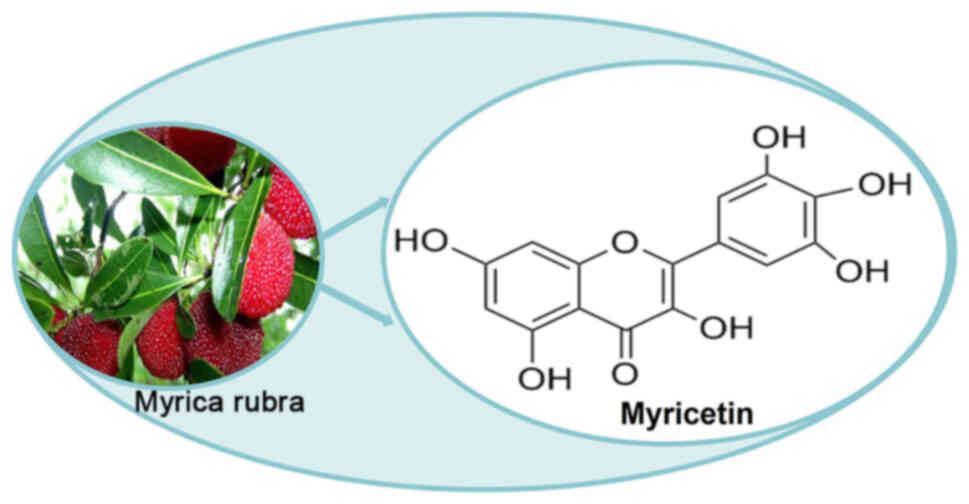 |
Figure 2
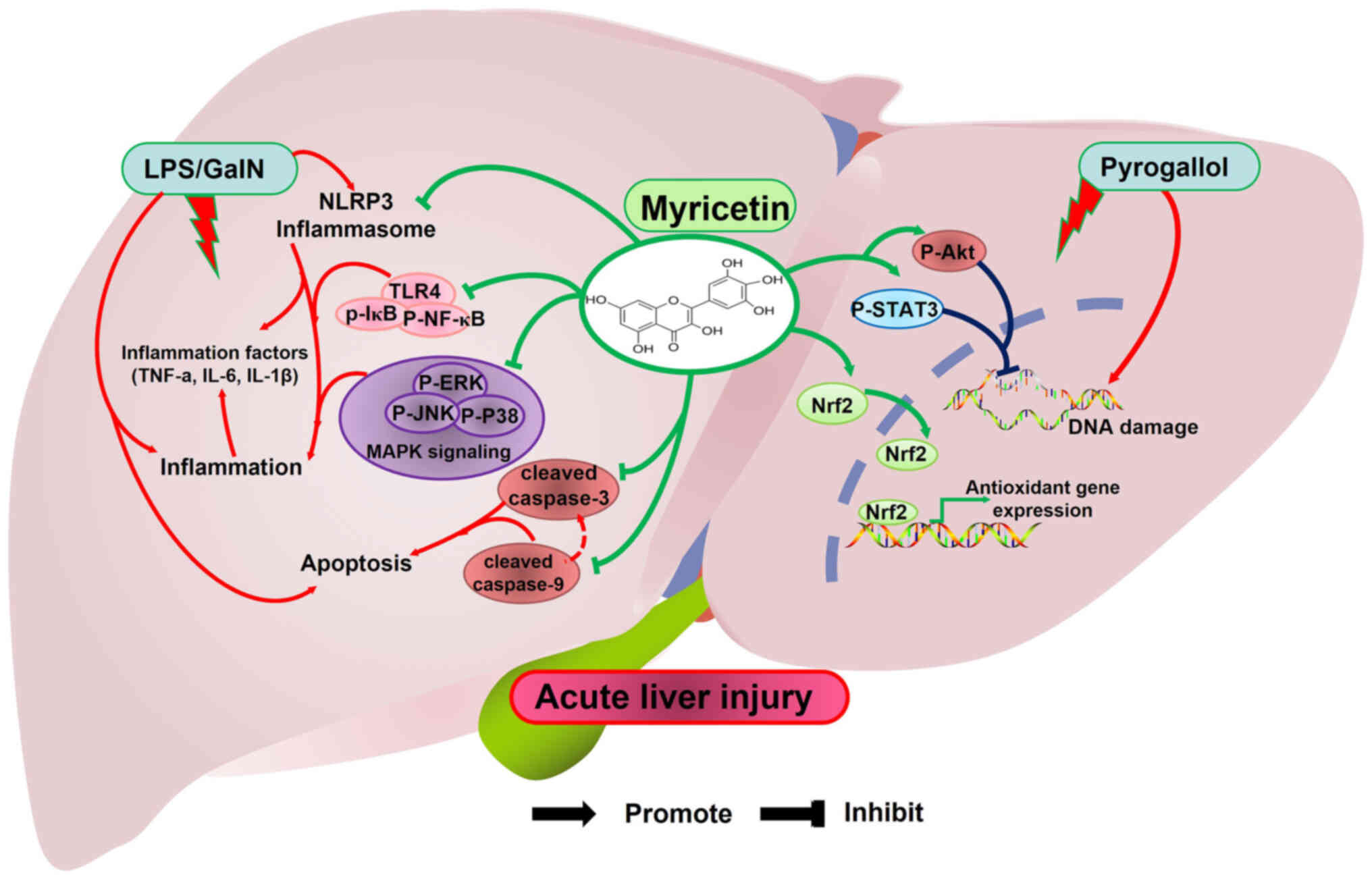 |
Figure 3
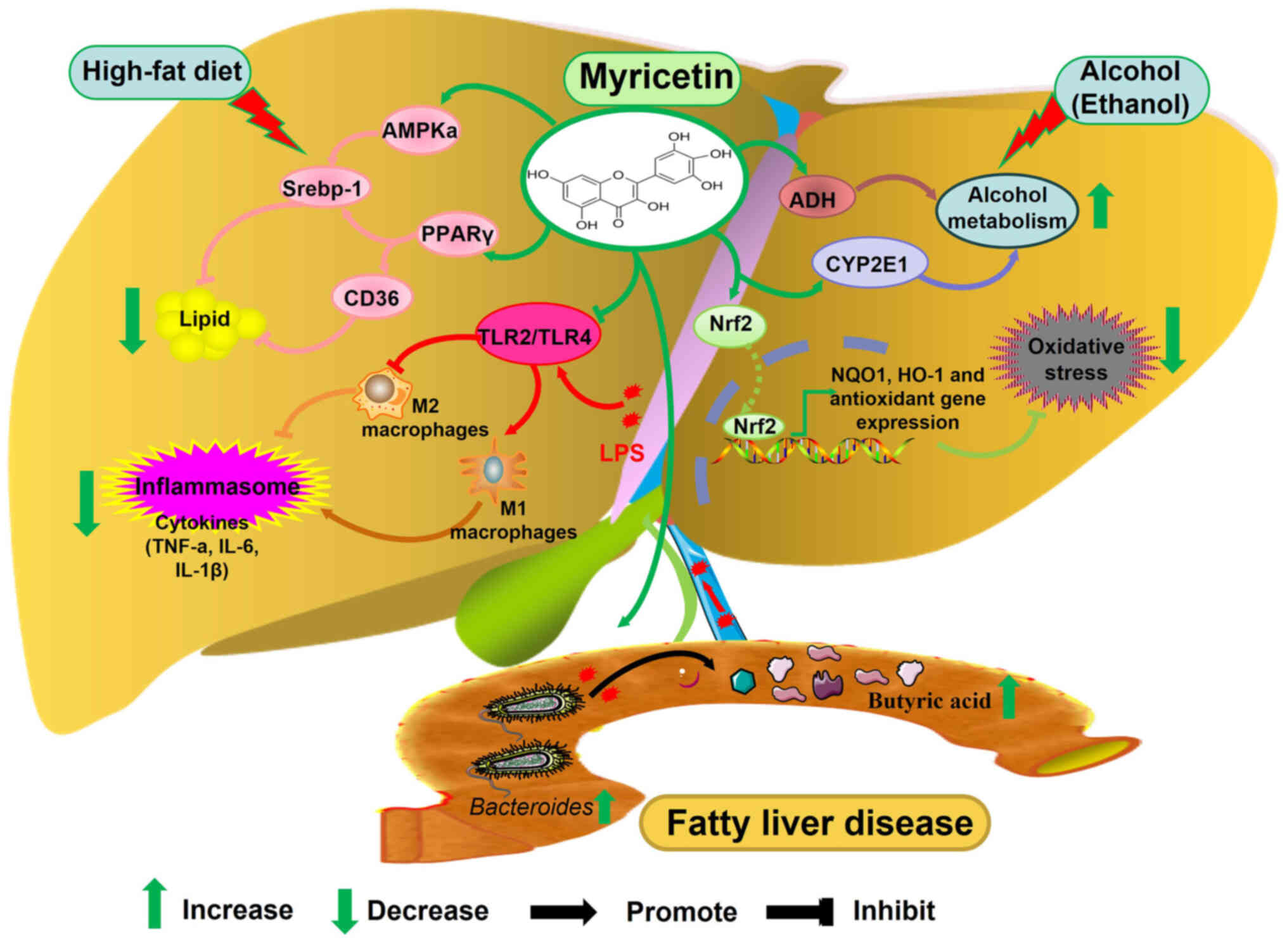 |
Figure 4
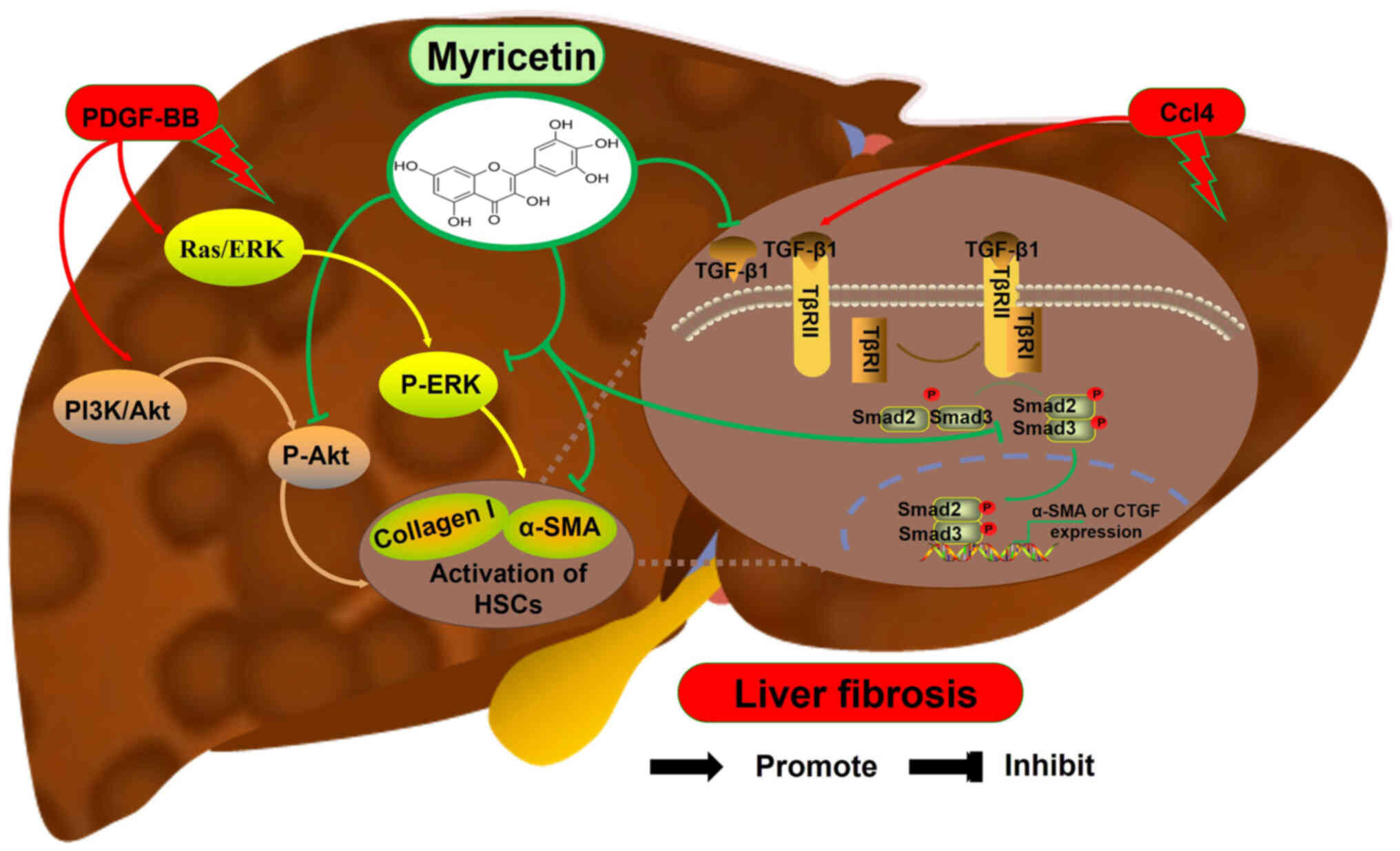 |
Figure 5
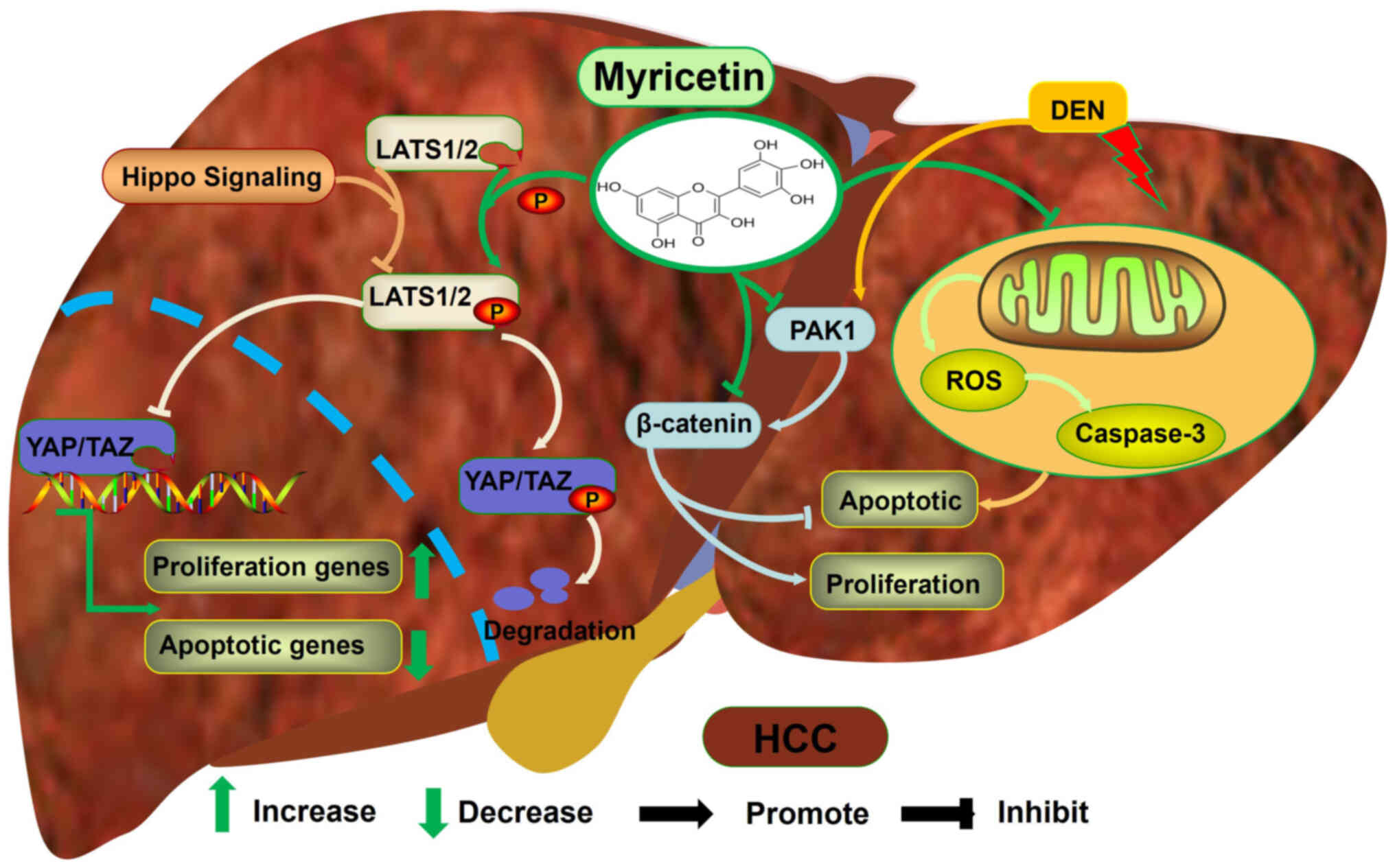 |
|
Frazier K, Manzoor S, Carroll K, DeLeon O, Miyoshi S, Miyoshi J, St George M, Tan A, Chrisler EA, Izumo M, et al: Gut microbes and the liver circadian clock partition glucose and lipid metabolism. J Clin Invest. 133:e1625152023. View Article : Google Scholar : PubMed/NCBI | |
|
Sinha RA, Singh BK and Yen PM: Direct effects of thyroid hormones on hepatic lipid metabolism. Nat Rev Endocrinol. 14:259–269. 2018. View Article : Google Scholar : PubMed/NCBI | |
|
Sun J, Yu X, Weng Z, Jin L and Yang J, Zhang H, Gu J, Wang N and Yang J: The impact of hepatotoxic drugs on the outcome of patients with acute deterioration of hepatitis B virus-related chronic disease. Eur J Gastroenterol Hepatol. 34:782–790. 2022.PubMed/NCBI | |
|
Devarbhavi H, Asrani SK, Arab JP, Nartey YA, Pose E and Kamath PS: Global burden of liver disease: 2023 update. J Hepatol. 79:516–537. 2023. View Article : Google Scholar : PubMed/NCBI | |
|
Pate J, Gutierrez JA, Frenette CT, Goel A, Kumar S, Manch RA, Mena EA, Pockros PJ, Satapathy SK, Yimam KK and Gish RG: Practical strategies for pruritus management in the obeticholic acid-treated patient with PBC: Proceedings from the 2018 expert panel. BMJ Open Gastroenterol. 6:e0002562019. View Article : Google Scholar : PubMed/NCBI | |
|
Zhu YJ, Zheng B, Wang HY and Chen L: New knowledge of the mechanisms of sorafenib resistance in liver cancer. Acta Pharmacol Sin. 38:614–622. 2017. View Article : Google Scholar : PubMed/NCBI | |
|
Semwal DK, Semwal RB, Combrinck S and Viljoen A: Myricetin: A dietary molecule with diverse biological activities. Nutrients. 8:902016. View Article : Google Scholar : PubMed/NCBI | |
|
Nardini M and Garaguso I: Characterization of bioactive compounds and antioxidant activity of fruit beers. Food Chem. 305:1254372020. View Article : Google Scholar : PubMed/NCBI | |
|
Jiang C, Xie L, Wang Y, Liang J, Li H, Luo L, Li T, Liang Z, Tang L, Ning D, et al: Highly sensitive electrochemical detection of myricetin in food samples based on the enhancement effect of Al-MOFs. Anal Methods. 14:3521–3528. 2022. View Article : Google Scholar : PubMed/NCBI | |
|
Klimek-Szczykutowicz M, Gaweł-Bęben K, Rutka A, Blicharska E, Tatarczak-Michalewska M, Kulik-Siarek K, Kukula-Koch W, Malinowska MA and Szopa A: Moringa oleifera (drumstick tree)-nutraceutical, cosmetological and medicinal importance: A review. Front Pharmacol. 15:12883822024. View Article : Google Scholar : PubMed/NCBI | |
|
Wang M, Ren S, Bi Z, Zhang L, Cui M, Sun R, Bao J, Gao D, Yang B, Li X, et al: Myricetin reverses epithelial-endothelial transition and inhibits vasculogenic mimicry and angiogenesis of hepatocellular carcinoma by directly targeting PAR1. Phytother Res. 36:1807–1821. 2022. View Article : Google Scholar : PubMed/NCBI | |
|
Rostami A, Baluchnejadmojarad T and Roghani M: Hepatoprotective effect of myricetin following Lipopolysaccharide/DGalactosamine: Involvement of autophagy and sirtuin 1. Curr Mol Pharmacol. 16:419–433. 2023. View Article : Google Scholar : PubMed/NCBI | |
|
Perkin AG and Hummel JJ: LXXVI-The colouring principle contained in the bark of Myrica nagi part I. J Chem Soc Trans. 69:1287–1294. 1896. View Article : Google Scholar | |
|
Ozcan C and Yaman M: Determination of Myricetin in medicinal plants by high-performance liquid chromatography. In strum Sci Technol. 43:44–52. 2015. | |
|
Perkin AG: XXI.-Myricetin. Part II. J Chem Soc Trans. 81:203–210. 1902. View Article : Google Scholar | |
|
He J, Wang Y, Chang AK, Xu L, Wang N, Chong X, Li H, Zhang B, Jones GW and Song Y: Myricetin prevents fibrillogenesis of hen egg white lysozyme. J Agric Food Chem. 62:9442–9449. 2014. View Article : Google Scholar : PubMed/NCBI | |
|
Jiang M, Zhu M, Wang L and Yu S: Anti-tumor effects and associated molecular mechanisms of myricetin. Biomed Pharmacother. 120:1095062019. View Article : Google Scholar : PubMed/NCBI | |
|
Zhou JL, Chen HH, Xu J, Huang MY, Wang JF, Shen HJ, Shen SX, Gao CX and Qian CD: Myricetin acts as an inhibitor of type II NADH Dehydrogenase from Staphylococcus aureus. Molecules. 29:23542024. View Article : Google Scholar : PubMed/NCBI | |
|
Hou DD, Gu YJ, Wang DC, Niu Y, Xu ZR, Jin ZQ, Wang XX and Li SJ: Therapeutic effects of myricetin on atopic dermatitis in vivo and in vitro. Phytomedicine. 102:1542002022. View Article : Google Scholar : PubMed/NCBI | |
|
Li Q, Tan Q, Ma Y, Gu Z and Chen S: Myricetin suppresses ovarian cancer in vitro by activating the p38/Sapla signaling pathway and suppressing intracellular oxidative stress. Front Oncol. 12:9033942022. View Article : Google Scholar : PubMed/NCBI | |
|
Shrivastava R and Chng SS: Lipid trafficking across the Gram-negative cell envelope. J Biol Chem. 294:14175–14184. 2019. View Article : Google Scholar : PubMed/NCBI | |
|
Wang P, Han X, Mo B, Huang G and Wang C: LPS enhances TLR4 expression and IFN-γ production via the TLR4/IRAK/NF-κB signaling pathway in rat pulmonary arterial smooth muscle cells. Mol Med Rep. 16:3111–3116. 2017. View Article : Google Scholar : PubMed/NCBI | |
|
Fuchs O: Transcription factor NF-κB inhibitors as single therapeutic agents or in combination with classical chemotherapeutic agents for the treatment of hematologic malignancies. Curr Mol Pharmacol. 3:98–122. 2010. View Article : Google Scholar : PubMed/NCBI | |
|
Xiao P, Li M, Zhou M, Zhao X, Wang C, Qiu J, Fang Q, Jiang H, Dong H and Zhou R: TTP protects against acute liver failure by regulating CCL2 and CCL5 through m6A RNA methylation. JCI Insight. 6:e1492762021. View Article : Google Scholar : PubMed/NCBI | |
|
Berköz M, Ünal S, Karayakar F, Yunusoğlu O, Özkan-Yılmaz F, Özlüer-Hunt A and Aslan A: Prophylactic effect of myricetin and apigenin against lipopolysaccharide-induced acute liver injury. Mol Biol Rep. 48:6363–6373. 2021. View Article : Google Scholar : PubMed/NCBI | |
|
Kim JM, Cho SS, Kang S, Moon C, Yang JH and Ki SH: Castanopsis sieboldii extract alleviates acute liver injury by antagonizing inflammasome-mediated pyroptosis. Int J Mol Sci. 24:119822023. View Article : Google Scholar : PubMed/NCBI | |
|
Lv H, An B, Yu Q, Cao Y, Liu Y and Li S: Prophylactic effect of myricetin and apigenin against lipopolysaccharide-induced acute liver injury lipopolysaccharide and D-galactosamine-induced fulminant hepatitis. Int J Biol Macromol. 155:1092–1104. 2020. View Article : Google Scholar : PubMed/NCBI | |
|
Lee HJ, Oh YK, Rhee M, Lim JY, Hwang JY, Park YS, Kwon Y, Choi KH, Jo I, Park SI, et al: The role of STAT1/IRF-1 on synergistic ROS production and loss of mitochondrial transmembrane potential during hepatic cell death induced by LPS/d-GalN. J Mol Biol. 369:967–984. 2007. View Article : Google Scholar : PubMed/NCBI | |
|
Sheftel AD, Kim SF and Ponka P: Non-heme induction of heme oxygenase-1 does not alter cellular iron metabolism. J Biol Chem. 282:10480–10486. 2007. View Article : Google Scholar : PubMed/NCBI | |
|
Lin L, Wu Q, Lu F, Lei J, Zhou Y, Liu Y, Zhu N, Yu Y, Ning Z, She T and Hu M: Nrf2 signaling pathway: Current status and potential therapeutic targetable role in human cancers. Front Oncol. 13:11840792023. View Article : Google Scholar : PubMed/NCBI | |
|
Huang J, Wu L, Tashiro S, Onodera S and Ikejima T: Reactive oxygen species mediate oridonin-induced HepG2 apoptosis through p53, MAPK, and mitochondrial signaling pathways. J Pharmacol Sci. 107:370–379. 2008. View Article : Google Scholar : PubMed/NCBI | |
|
Miyashita T, Krajewski S, Krajewska M, Wang HG, Lin HK, Liebermann DA, Hoffman B and Reed JC: Tumor suppressor p53 is a regulator of bcl-2 and bax gene expression in vitro and in vivo. Oncogene. 9:1799–1805. 1994.PubMed/NCBI | |
|
Garrido C, Galluzzi L, Brunet M, Puig PE, Didelot C and Kroemer G: Mechanisms of cytochrome c release from mitochondria. Cell Death Differ. 13:1423–1433. 2006. View Article : Google Scholar : PubMed/NCBI | |
|
Nagata S, Nagase H, Kawane K, Mukae N and Fukuyama H: Degradation of chromosomal DNA during apoptosis. Cell Death Differ. 10:108–116. 2003. View Article : Google Scholar : PubMed/NCBI | |
|
Shih PC: The role of the STAT3 signaling transduction pathways in radioresistance. Pharmacol Ther. 234:1081182022. View Article : Google Scholar : PubMed/NCBI | |
|
Matić S, Stanić S, Bogojević D, Vidaković M, Grdović N, Dinić S, Solujić S, Mladenović M, Stanković N and Mihailović M: Methanol extract from the stem of Cotinus coggygria Scop., and its major bioactive phytochemical constituent myricetin modulate pyrogallol-induced DNA damage and liver injury. Mutat Res. 755:81–89. 2013. View Article : Google Scholar : PubMed/NCBI | |
|
Chang CJ, Tzeng TF, Liou SS, Chang YS and Liu IM: myricetin increases hepatic peroxisome proliferator-activated receptor α protein expression and decreases plasma lipids and adiposity in rats. Evid Based Complement Alternat Med. 2012:7871522012. View Article : Google Scholar : PubMed/NCBI | |
|
Guo C, Xue G, Pan B, Zhao M, Chen S, Gao J, Chen T and Qiu L: Myricetin ameliorates ethanol-induced lipid accumulation in liver cells by reducing fatty acid biosynthesis. Mol Nutr Food Res. 63:e18013932019. View Article : Google Scholar : PubMed/NCBI | |
|
Wang W, Zhai T, Luo P, Miao X, Wang J and Chen Y: Beneficial effects of silibinin on serum lipids, bile acids, and gut microbiota in methionine-choline-deficient diet-induced mice. Front Nutr. 10:12571582023. View Article : Google Scholar : PubMed/NCBI | |
|
Wang C, Gong B, Peng D, Liu Y, Wu Y and Wei J: Agarwood extract mitigates alcoholic fatty liver in C57 mice via anti oxidation and anti inflammation. Mol Med Rep. 28:2102023. View Article : Google Scholar : PubMed/NCBI | |
|
Osna NA, Rasineni K, Ganesan M, Donohue TM Jr and Kharbanda KK: Pathogenesis of alcohol-associated liver disease. J Clin Exp Hepatol. 12:1492–1513. 2022. View Article : Google Scholar : PubMed/NCBI | |
|
Leung TM and Nieto N: CYP2E1 and oxidant stress in alcoholic and non-alcoholic fatty liver disease. J Hepatol. 58:395–398. 2013. View Article : Google Scholar : PubMed/NCBI | |
|
Ahmad SB, Rashid SM, Wali AF, Ali S, Rehman MU, Maqbool MT, Nadeem A, Ahmad SF and Siddiqui N: Myricetin (3,3′,4′,5,5′,7-hexahydroxyflavone) prevents ethanol-induced biochemical and inflammatory damage in the liver of Wistar rats. Hum Exp Toxicol. 41:96032712110668432022. View Article : Google Scholar : PubMed/NCBI | |
|
Schlaepfer IR and Joshi M: CPT1A-mediated fat oxidation, mechanisms, and therapeutic potential. Endocrinology. 161:bqz0462020. View Article : Google Scholar : PubMed/NCBI | |
|
Fang C, Pan J, Qu N, Lei Y, Han J, Zhang J and Han D: The AMPK pathway in fatty liver disease. Front Physiol. 13:9702922022. View Article : Google Scholar : PubMed/NCBI | |
|
Ludwig J, Viggiano TR, McGill DB and Oh BJ: Nonalcoholic steatohepatitis: Mayo Clinic experiences with a hitherto unnamed disease. Mayo Clin Proc. 55:434–438. 1980. View Article : Google Scholar : PubMed/NCBI | |
|
Lian CY, Zhai ZZ, Li ZF and Wang L: High fat diet-triggered non-alcoholic fatty liver disease: A review of proposed mechanisms. Chem Biol Interact. 330:1091992020. View Article : Google Scholar : PubMed/NCBI | |
|
Li L, Sun H, Chen J, Ding C, Yang X, Han H and Sun Q: Mitigation of non-alcoholic steatohepatitis via recombinant Orosomucoid 2, an acute phase protein modulating the Erk1/2-PPARγ-Cd36 pathway. Cell Rep. 42:1126972023. View Article : Google Scholar : PubMed/NCBI | |
|
Chen H, Tan H, Wan J, Zeng Y, Wang J, Wang H and Lu X: PPAR-γ signaling in nonalcoholic fatty liver disease: Pathogenesis and therapeutic targets. Pharmacol Ther. 245:1083912023. View Article : Google Scholar : PubMed/NCBI | |
|
Xia SF, Qiu YY, Chen LM, Jiang YY, Huang W, Xie ZX, Tang and Sun J: Myricetin alleviated hepatic steatosis by acting on microRNA-146b/thyroid hormone receptor b pathway in high-fat diet fed C57BL/6J mice. Food Funct. 10:1465–1477. 2019. View Article : Google Scholar : PubMed/NCBI | |
|
Choi HN, Shin JY and Kim JI: Ameliorative effect of myricetin on nonalcoholic fatty liver disease in ob/ob Mice. J Med Food. 24:1092–1099. 2021. View Article : Google Scholar : PubMed/NCBI | |
|
Lei ZY, Li ZH, Lin DN, Cao J, Chen JF, Meng SB, Wang JL, Liu J, Zhang J and Lin BL: Med1 inhibits ferroptosis and alleviates liver injury in acute liver failure via Nrf2 activation. Cell Biosci. 14:542024. View Article : Google Scholar : PubMed/NCBI | |
|
Xia SF, Le GW, Wang P, Qiu YY, Jiang YY and Tang X: Regressive effect of myricetin on hepatic steatosis in mice fed a high-fat diet. Nutrients. 8:7992016. View Article : Google Scholar : PubMed/NCBI | |
|
Tang WHW, Li DY and Hazen SL: Dietary metabolism, the gut microbiome, and heart failure. Nat Rev Cardiol. 16:137–154. 2019. View Article : Google Scholar : PubMed/NCBI | |
|
van der Hee B and Wells JM: Microbial regulation of host physiology by short-chain fatty acids. Trends Microbiol. 29:700–712. 2021. View Article : Google Scholar : PubMed/NCBI | |
|
Beauvieux MC, Tissier P, Gin H, Canioni P and Gallis JL: Butyrate impairs energy metabolism in isolated perfused liver of fed rats. J Nutr. 131:1986–1992. 2001. View Article : Google Scholar : PubMed/NCBI | |
|
Zhang L, Chen N, Zhan L, Bi T, Zhou W, Zhang L and Zhu L: Erchen Decoction alleviates obesity-related hepatic steatosis via modulating gut microbiota-drived butyric acid contents and promoting fatty acid β-oxidation. J Ethnopharmacol. 317:1168112023. View Article : Google Scholar : PubMed/NCBI | |
|
Sun WL, Li XY, Dou HY, Wang XD, Li JD, Shen L and Ji HF: Myricetin supplementation decreases hepatic lipid synthesis and inflammation by modulating gut microbiota. Cell Rep. 36:1096412021. View Article : Google Scholar : PubMed/NCBI | |
|
Chelakkot C, Ghim J and Ryu SH: Mechanisms regulating intestinal barrier integrity and its pathological implications. Exp Mol Med. 50:1–9. 2018. View Article : Google Scholar : PubMed/NCBI | |
|
Xu M, Luo K, Li J, Li Y, Zhang Y, Yuan Z, Xu Q and Wu X: Role of intestinal microbes in chronic liver diseases. Int J Mol Sci. 23:126612022. View Article : Google Scholar : PubMed/NCBI | |
|
Peña-Rodríguez M, Vega-Magaña N, García-Benavides L, Zepeda-Nuño JS, Gutierrez-Silerio GY, González-Hernández LA, Andrade-Villanueva JF, Del Toro-Arreola S, Pereira-Suárez AL and Bueno-Topete MR: Butyrate administration strengthens the intestinal epithelium and improves intestinal dysbiosis in a cholestasis fibrosis model. J Appl Microbiol. 132:571–583. 2022. View Article : Google Scholar : PubMed/NCBI | |
|
Hirschfeld M, Weis JJ, Toshchakov V, Salkowski CA, Cody MJ, Ward DC, Qureshi N, Michalek SM and Vogel SN: Signaling by toll-like receptor 2 and 4 agonists results in differential gene expression in murine macrophages. Infect Immun. 69:1477–1482. 2001. View Article : Google Scholar : PubMed/NCBI | |
|
Yao Q, Li S, Li X, Wang F and Tu C: myricetin modulates macrophage polarization and mitigates liver inflammation and fibrosis in a murine model of nonalcoholic steatohepatitis. Front Med (Lausanne). 7:712020. View Article : Google Scholar : PubMed/NCBI | |
|
Yuan S, Wei C, Liu G, Zhang L, Li J, Li L, Cai S and Fang L: Sorafenib attenuates liver fibrosis by triggering hepatic stellate cell ferroptosis via HIF-1α/SLC7A11 pathway. Cell Prolif. 55:e131582022. View Article : Google Scholar : PubMed/NCBI | |
|
Yakymovych I, Yakymovych M, Hamidi A, Landström M and Heldin CH: The type II TGF-β receptor phosphorylates Tyr182 in the type I receptor to activate downstream Src signaling. Sci Signal. 15:eabp95212022. View Article : Google Scholar : PubMed/NCBI | |
|
Hu Y, Li Z, Gong L and Song Z: β-Asarone suppresses TGF-β/Smad signaling to reduce the invasive properties in esophageal squamous cancer cells. Med Oncol. 39:2432022. View Article : Google Scholar : PubMed/NCBI | |
|
Dewidar B, Meyer C, Dooley S and Meindl-Beinker AN: TGF-β in hepatic stellate cell activation and liver fibrogenesis-updated 2019. Cells. 8:14192019. View Article : Google Scholar : PubMed/NCBI | |
|
Huang P, Zhou M, Cheng S, Hu Y, Gao M, Ma Y, Limpanont Y, Zhou H, Dekumyoy P, Cheng Y and Lv Z: myricetin possesses anthelmintic activity and attenuates hepatic fibrosis via modulating TGFβ1 and Akt signaling and shifting Th1/Th2 balance in schistosoma japonicum-infected mice. Front Immunol. 11:5932020. View Article : Google Scholar : PubMed/NCBI | |
|
Li HG, You PT, Xia Y, Cai Y, Tu YJ, Wang MH, Song WC, Quan TM, Ren HY, Liu YW, et al: Yu Gan Long ameliorates hepatic fibrosis by inhibiting PI3K/AKT, Ras/ERK and JAK1/STAT3 signaling pathways in CCl4-induced liver fibrosis rats. Curr Med Sci. 40:539–547. 2020. View Article : Google Scholar : PubMed/NCBI | |
|
Geng Y, Sun Q, Li W, Lu ZM, Xu HY, Shi JS and Xu ZH: The common dietary flavonoid myricetin attenuates liver fibrosis in carbon tetrachloride treated mice. Mol Nutr Food Res. 61:2016003922017. View Article : Google Scholar | |
|
Domitrović R, Rashed K, Cvijanović O, Vladimir-Knežević S, Škoda M and Višnić A: Myricitrin exhibits antioxidant, anti-inflammatory and antifibrotic activity in carbon tetrachloride-intoxicated mice. Chem Biol Interact. 230:21–29. 2015. View Article : Google Scholar : PubMed/NCBI | |
|
Lee NH, Kim SJ and Hyun J: MicroRNAs regulating Hippo-YAP signaling in liver cancer. Biomedicines. 9:3472021. View Article : Google Scholar : PubMed/NCBI | |
|
Li M, Chen J, Yu X, Xu S, Li D, Zheng Q and Yin Y: Myricetin suppresses the propagation of hepatocellular carcinoma via down-regulating expression of YAP. Cells. 8:3582019. View Article : Google Scholar : PubMed/NCBI | |
|
He H, Huynh N, Liu KH, Malcontenti-Wilson C, Zhu J, Christophi C, Shulkes A and Baldwin GS: P-21 activated kinase 1 knockdown inhibits β-catenin signalling and blocks colorectal cancer growth. Cancer Lett. 317:65–71. 2012. View Article : Google Scholar : PubMed/NCBI | |
|
Iyer SC, Gopal A and Halagowder D: Myricetin induces apoptosis by inhibiting P21 activated kinase 1 (PAK1) signaling cascade in hepatocellular carcinoma. Mol Cell Biochem. 407:223–237. 2015. View Article : Google Scholar : PubMed/NCBI | |
|
Lee HY, Nga HT, Tian J and Yi HS: Mitochondrial metabolic signatures in hepatocellular carcinoma. Cells. 10:19012021. View Article : Google Scholar : PubMed/NCBI | |
|
Cardin R, Piciocchi M, Bortolami M, Kotsafti A, Barzon L, Lavezzo E, Sinigaglia A, Rodriguez-Castro KI, Rugge M and Farinati F: Oxidative damage in the progression of chronic liver disease to hepatocellular carcinoma: An intricate pathway. World J Gastroenterol. 20:3078–3086. 2014. View Article : Google Scholar : PubMed/NCBI | |
|
Chandel NS and Tuveson DA: The promise and perils of antioxidants for cancer patients. N Engl J Med. 371:177–178. 2014. View Article : Google Scholar : PubMed/NCBI | |
|
Seydi E, Rasekh HR, Salimi A, Mohsenifar Z and Pourahmad J: Myricetin selectively induces apoptosis on cancerous hepatocytes by directly targeting their mitochondria. Basic Clin Pharmacol Toxicol. 119:249–258. 2016. View Article : Google Scholar : PubMed/NCBI | |
|
Yang Y, Choi JK, Jung CH, Koh HJ, Heo P, Shin JY, Kim S, Park WS, Shin HJ and Kweon DH: SNARE-wedging polyphenols as small molecular botox. Planta Med. 8:233–236. 2012. View Article : Google Scholar : PubMed/NCBI | |
|
Kim JD, Liu L, Guo W and Meydani M: Chemical structure of flavonols in relation to modulation of angiogenesis and immune-endothelial cell adhesion. J Nutr Biochem. 7:165–176. 2006. View Article : Google Scholar | |
|
Canada AT, Watkins WD and Nguyen TD: The toxicity of flavonoids to guinea pig enterocytes. Toxicol Appl Pharmacol. 99:357–361. 1989. View Article : Google Scholar : PubMed/NCBI | |
|
Canada AT, Giannella E, Nguyen TD and Mason RP: The production of reactive oxygen species by dietary flavonols. Free Radic Biol Med. 9:441–449. 1990. View Article : Google Scholar : PubMed/NCBI |











